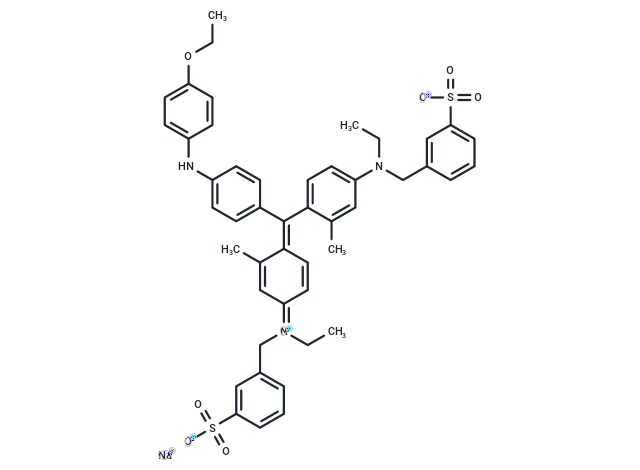Shopping Cart
- Remove All
 Your shopping cart is currently empty
Your shopping cart is currently empty

Brilliant blue G-250 (Acid blue 90, Coomassie Brilliant Blue G) is an antagonist of the P2X7 purinergic receptor.

| Pack Size | Price | Availability | Quantity |
|---|---|---|---|
| 25 mg | $35 | In Stock | |
| 50 mg | $48 | In Stock | |
| 100 mg | $72 | In Stock | |
| 200 mg | $97 | In Stock | |
| 500 mg | $176 | In Stock |
| Description | Brilliant blue G-250 (Acid blue 90, Coomassie Brilliant Blue G) is an antagonist of the P2X7 purinergic receptor. |
| Alias | Brilliant Blue G, BBG, Acid blue 90, Coomassie Brilliant Blue G |
| Molecular Weight | 854.02 |
| Formula | C47H48N3NaO7S2 |
| Cas No. | 6104-58-1 |
| Smiles | O=S(C1=CC=CC(CN(CC)C2=CC=C(/C(C3=CC=C(NC4=CC=C(OCC)C=C4)C=C3)=C5C(C)=C/C(C=C/5)=[N+](CC)\CC6=CC=CC(S(=O)([O-])=O)=C6)C(C)=C2)=C1)([O-])=O.[Na+] |
| Relative Density. | 1.274 g/cm3. Temperature:20 °C. |
| Storage | keep away from direct sunlight | Powder: -20°C for 3 years | In solvent: -80°C for 1 year | Shipping with blue ice. | ||||||||||||||||||||
| Solubility Information | DMSO: 8.54 mg/mL (10 mM), Sonication is recommended. | ||||||||||||||||||||
Solution Preparation Table | |||||||||||||||||||||
DMSO
| |||||||||||||||||||||

Copyright © 2015-2025 TargetMol Chemicals Inc. All Rights Reserved.